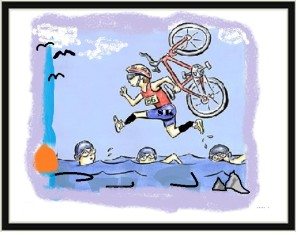As a sports dietitian, as well as an endurance athlete
(triathlon and marathons) that struggles to lose weight, I often find myself
frustrated with the low response my body has to my consistent training and very
disciplined eating habits. I also have many athletic clients that struggle with
the same dynamic. I thus began to research the concept of “Metabolic Efficiency”,
defined as “Energy intake based on body weight that is required to maintain
current weight.” I even went as far as
having a basal metabolic rate test done, only to discover mine was off the charts
(low). This demonstrated to me that just
to maintain my current body weight (without gaining), or to drop even a minimal
amount, required less energy (calories) than my already restrictive daily
intake even with an above average of training hours per week. So what then is metabolic
efficiency and does it exist? Am I that efficient as a machine – that I do not
need much fuel, even with a high demand of training hours. Maybe I am the new
model of “green,” the “Prius” of the athlete model. Yes, metabolic efficiency
seems to have a positive ring to it, but it can be an especially frustrating
state for those that seek weight loss as a benefit of endurance training.
This is not a new concept. In fact, in the early 80s,
researchers highlighted the potential for energy efficiency among athletes when
many competitive athletes reported what would seem to be inadequate energy
consumption to meet the demands of their excessive training regimens. (Drinkwater, Deutser, Dahlstrom, Beidelmann). Based on the energy balance equation (energy
consumed equals energy expended), one would expect these athletes not only to
jeopardize their performance with such low intakes, but to drop weight
drastically. However, evidence showed that triathletes, gymnasts, marathoners
and distance swimmers maintained their body mass over extended periods despite
low energy intakes (less than 35 calories per kilogram of body weight). Thompson
et al, studied 24 endurance athletes with the same number of hours of training
in a week. Some of the athletes
typically ate less than adequate energy and others had above adequate energy
for their training demands (there was a difference of almost 1500 calorie per
day intake between the two groups). Thompson’s results definitely leaned
towards metabolic efficiency existing, because regardless of the difference in
energy intake, both groups’ body composition (body fat and muscle percentages)
remained stable for over two years.
One could easily argue that what athletes reported as
intake, may be under-reported. This in fact, is a common phenomenon, particularly
in athletes of aesthetic sports, where body image distortion runs rampant.
Wilmore and Schultz measured energy expenditure in female runners in a
respiratory chamber. Their experimental group reported significantly lower
energy intakes than their training would require but the measured energy
expenditure showed no evidence of metabolic efficiency. In these studies,
metabolic efficiency has a more objective, physiological definition: a lowered
resting metabolic rate and an increased energy expenditure during intense
activity. In similar studies, Beidelmann in 1995, like Wilmore and Schulz, found
no significant changes in resting metabolic rate or energy expenditure (rate of
oxygen consumption). With this definition secured, the only conclusion these
researchers could draw, was that the runners were under reporting energy intake.
Thompson et al, argued for metabolic efficiency again in his
1995 research. Here he set out to determine if activity energy expenditure,
sleep energy expenditure and resting heart rate in endurance athletes were
similar over a 24 hour period rather than an extended time, and also measured
oxygen consumption in a respiratory chamber.
Surprisingly, lower energy-intake athletes (low again by almost 1500
calories of estimated energy requirements for the experimental activity) had
physical energy expenditure, resting metabolic rate, and sleep energy
expenditure lower than the adequate-intake athletes. Furthermore, he controlled
the athletes’ intake, thereby preventing over or under reporting in this short
duration.
My initial perception of metabolic efficiency (very slow
metabolism) was now totally upended by this research. Perhaps I underreported my food intake oroverstated my levels of activity. The research found that many physically active people are more sedentary in the non-exercising portions of their day which would negate the perception of less energy intake would lead to a drop in body mass. To take this even further,
athletes (particularly ones that are highly competitive, or involved in high
intensity endurance sports) typically have an extended recovery season when
their much training regimen decreases, as compared to their short (probably 2
or 3 months at the most) peak season.
In most of these studies, resting metabolic rate, energy
expenditure during exercise, and an average of daily energy expenditure
provided the measure of metabolic efficiency. These measurements of metabolic
efficiency can be helpful for many, especially athletes in aesthetic sports who
can justify eating less yet still perform effectively. For endurance athletes,
it may take longer for them to “hit the wall” as they burn less calories and
spare more glycogen during their events. However, for many recreational
athletes, often choosing to participate in a sport for the benefit of being
able to eat more and still lose weight, metabolic efficiency may result in
frustration unless they have a deeper understanding of the concept. Based on
experience with my recreational athlete clients, many often think that training
will allows them to eat more. The research above helped carve out a good
summary for these athletes: unless metabolism is raised simultaneous with
training, weight gain is more likely to result versus weight loss.
A higher metabolism means a higher consumption of oxygen,
the rate at which the body burns calories. This includes at rest and during
exercise. Duration, intensity of workouts, as well as body composition and food
consumption, not only determine calories burned during workouts, but also
calories that continue to burn post work outs. Exercise itself is the highest
contributor to increasing ones metabolism and those of us wanting to reverse
our efficient metabolisms may need to take a closer look at how we work out.
Our diet does contribute to overall metabolism (calories burned based on
composition of macronutrients/ the thermic effect of food) but to a lesser
extent than exercise. Whether it is a
high intensity aerobic workout or a lower intensity longer duration work out,
or even a muscle building weight lifting session in the gym, all of these
contribute in some way to raising one’s metabolism. Our metabolic rate also
affects the rate at which we burn calories at rest, a concept referred to as
“excess post exercise oxygen consumption” or EPOC. So am I really metabolically efficient, or do
I need to look at the big picture: measured Oxygen consumption, an exercise
routine that maximizes EPOC, journaling and calculating energy intake versus
energy expenditure instead of estimating it?
References:
- Beidem BA, et al. Energy balance in female distance runners. Am J Clinical
Nutrition. 1995;61:303-11. - Dahlstrom M, et al. Discrepancy between estimated energy intake and requirements in
female dancers. Clin Physiol 1990; 10: 11-25. - Duester PA, et al. Nutritional intakes and status of highly trained women runners.
Fertil Steril 1986; 46: 636-43. - Drinkwater BL, et al. Bone mineral content of athletes. N Engl J med 1984;311:277-81.
- Fitzgerald, Matt. Running Hot. The facts and fallacies elevating resting metabolism.
2009. www.poweringmuscles.com. - Schulz LO, et al. Energy expenditure of elite runners measured by respiratory
chamber. J Appl Physiol 1992;72:23-8. - Thompson JL, et al. Resting metabolic rate and thermic effect of meal in low and
adequate energy intake in endurance athletes. Intl J Sports Nutr
1993;3:194-206. - Thompson JL, et al. Daily energy expenditure in male endurance athletes with
differing energy intakes. Med Sci Sports Exerc 1995;27:347-54. - Wilmore JH, et al.Is there energy conservation in distance runners? J Appl Physiol
1992;72:15-22.




Great article Alana,
It seems like a never ending struggle. I wish we could take a magic pill and be as slim as we would like to be.
Anyway this was a wonderful article and so well written, well done
I see a lot of interesting posts on your website. You have to spend a lot of time
writing, i know how to save you a lot of work, there is a tool that creates readable, SEO
friendly articles in couple of seconds, just type in google – k2 unlimited content